文章目录
一、IP地址
1、网页编程:B/S架构(Browser/Server(浏览器/服务器))
2、客户端服务器编程:C/S架构(Client/Server(客户端/服务器))
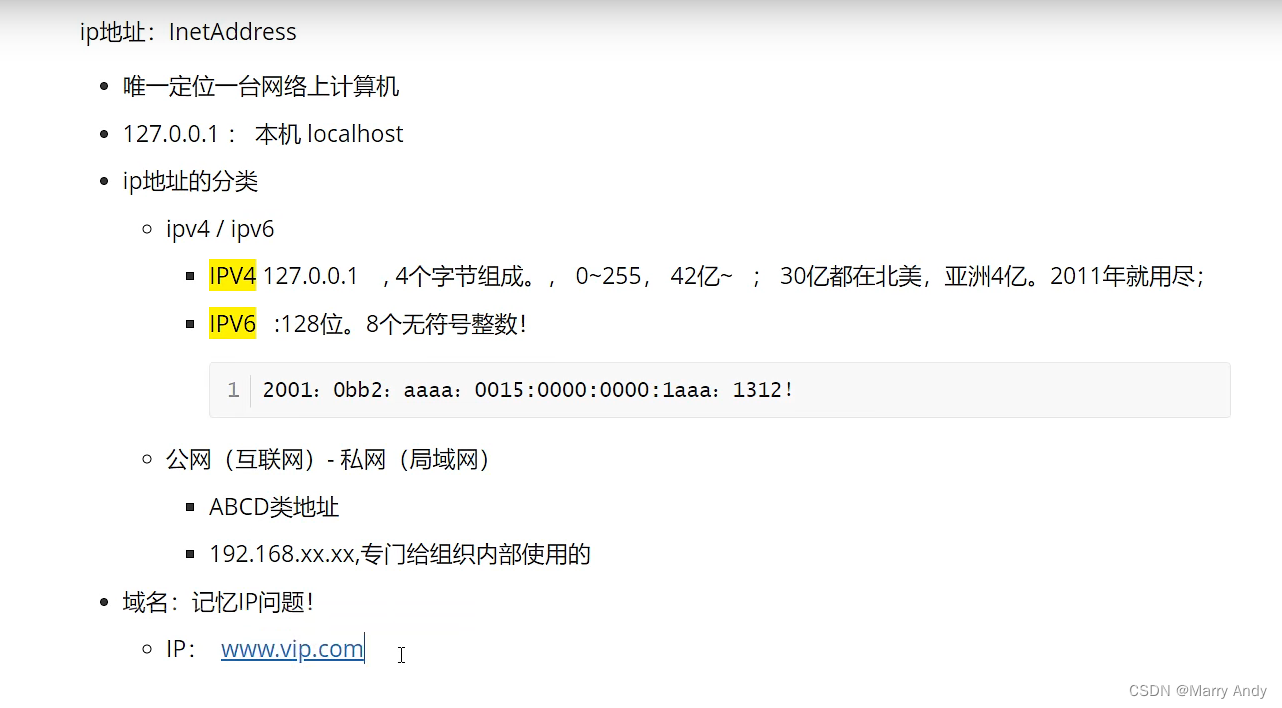
具体IPV4,IPV6的区别请看:https://zhuanlan.zhihu.com/p/271708071
3、InetAddress类
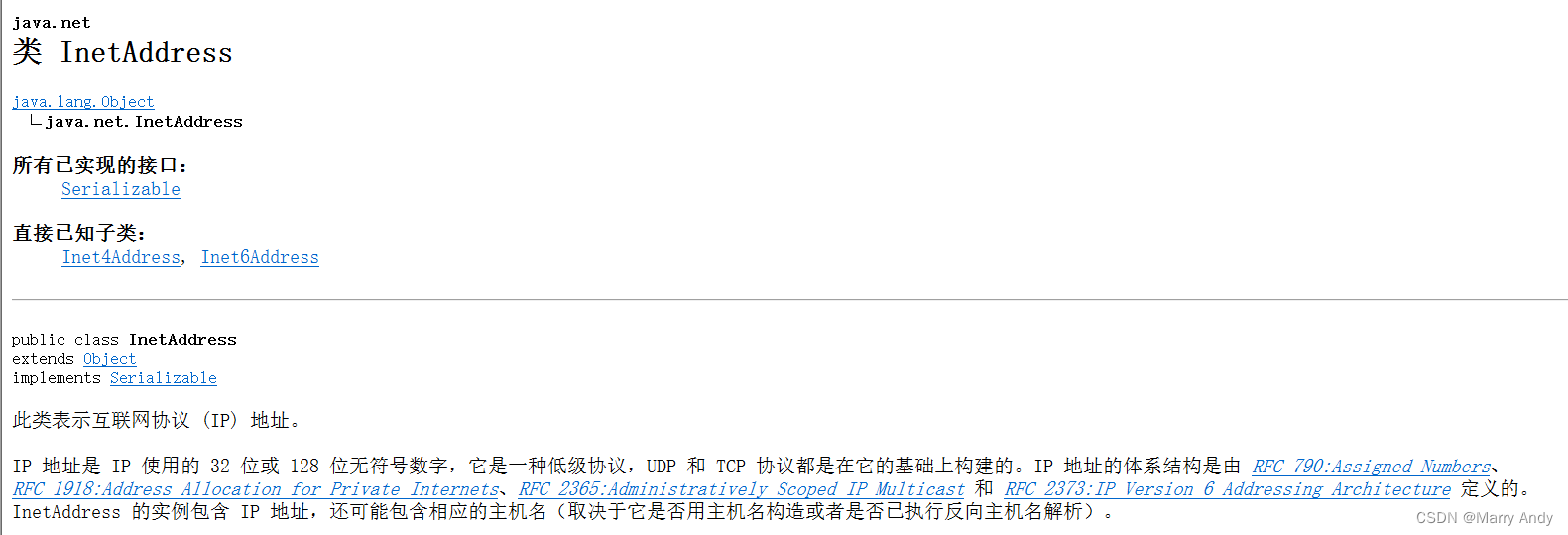
import java.net.InetAddress;
import java.net.UnknownHostException;
/**
1. @Author marryandy
2. @date 2022/4/21 16:08
3. @Version 1.0
4. @Description
*/
public class TestInetAddress {
public static void main(String[] args) {
try {
//查询本机地址
InetAddress inetAddress1 = InetAddress.getByName("127.0.0.1");
System.out.println(inetAddress1);
InetAddress inetAddress2 = InetAddress.getByName("Localhost");
System.out.println(inetAddress2);
InetAddress inetAddress3 = InetAddress.getLocalHost();
System.out.println(inetAddress3);
//查询网络IP地址
InetAddress inetAddress4 = InetAddress.getByName("www.baidu.com");
System.out.println(inetAddress4);
//输出规范的IP
System.out.println(inetAddress4.getCanonicalHostName());
//获得IP地址
System.out.println(inetAddress4.getHostAddress());
//获得域名或者自己电脑的名字
System.out.println(inetAddress4.getHostName());
} catch (UnknownHostException e) {
e.printStackTrace();
}
}
}

4、端口
详见:https://note.youdao.com/s/ZV5G7Vbw
5、InetSocketAddress类
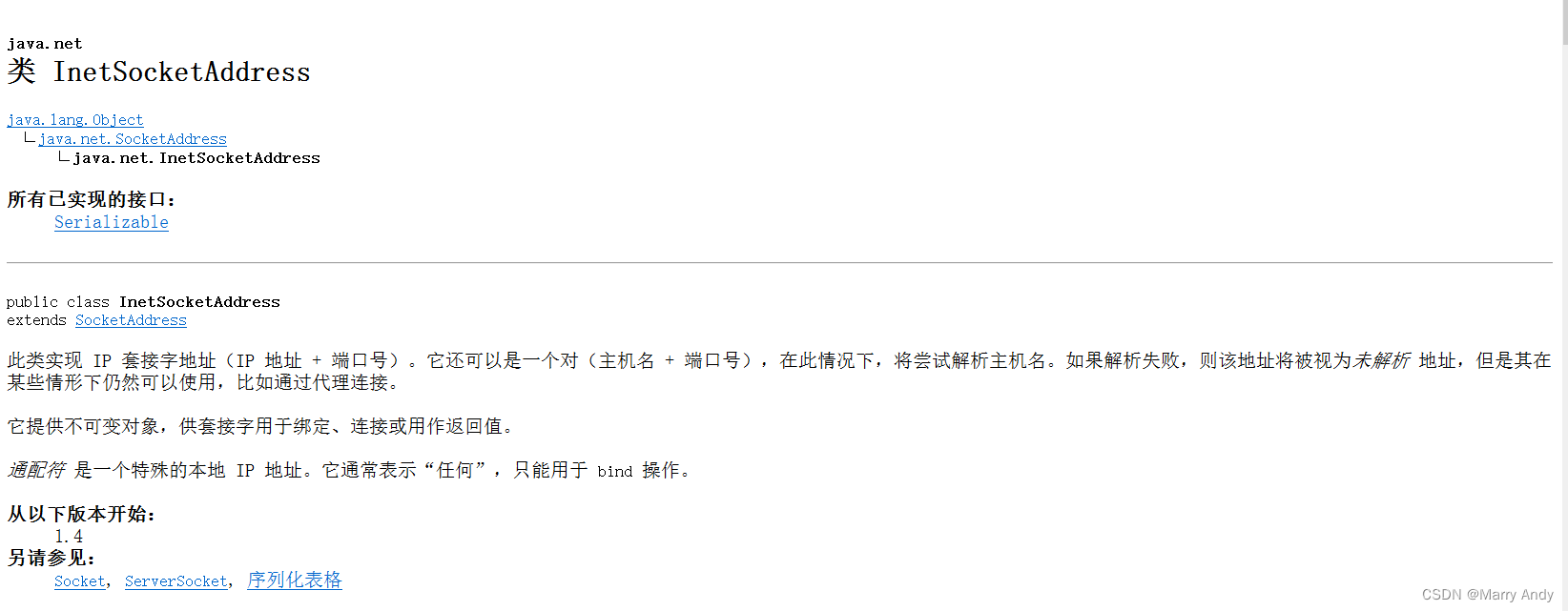
import java.net.InetSocketAddress;
/**
* @Author marryandy
* @date 2022/4/21 17:44
* @Version 1.0
* @Description
*/
public class TestInetSocketAddress {
public static void main(String[] args) {
InetSocketAddress inetSocketAddress1 = new InetSocketAddress("127.0.0.1",8080);
System.out.println(inetSocketAddress1);
InetSocketAddress inetSocketAddress2 = new InetSocketAddress("localhost",8080);
System.out.println(inetSocketAddress2);
System.out.println(inetSocketAddress1.getAddress());
//HostName 可以在host文件下进行修改
System.out.println(inetSocketAddress1.getHostName());
System.out.println(inetSocketAddress1.getPort());
}
}

二、TCP实现聊天
通信协议基本知识,详见:https://note.youdao.com/s/11qoeUvF
//客户端
import java.io.IOException;
import java.io.OutputStream;
import java.net.InetAddress;
import java.net.Socket;
import java.net.UnknownHostException;
import java.util.Scanner;
/**
* @Author marryandy
* @date 2022/4/21 19:59
* @Version 1.0
* @Description
*/
public class TcpClientDemo01 {
public static void main(String[] args) {
Socket socket = null;
OutputStream os = null;
try {
Scanner sc = new Scanner(System.in);
//1.知道服务器的地址
InetAddress serverIp = InetAddress.getByName("127.0.0.1");
//2.端口号
int port = 9999;
//3.创建一个socket连接
while(true){
socket = new Socket(serverIp,port);
//4.发送消息IO流
os = socket.getOutputStream();
String str = sc.nextLine();
os.write(str.getBytes());
if(str.equals("bye")){
break;
}
// os.flush();
os.close();
}
} catch (Exception e) {
throw new RuntimeException(e);
}finally{
//关闭资源:从下向上关闭,先开后关
if(os != null){
try {
os.close();
} catch (IOException e) {
throw new RuntimeException(e);
}
}
if(socket != null){
try {
socket.close();
} catch (IOException e) {
throw new RuntimeException(e);
}
}
}
}
}
//服务端
import java.io.ByteArrayOutputStream;
import java.io.IOException;
import java.io.InputStream;
import java.net.ServerSocket;
import java.net.Socket;
/**
* @Author marryandy
* @date 2022/4/21 19:59
* @Version 1.0
* @Description
*/
public class TcpServerDemo01 {
public static void main(String[] args) {
ServerSocket serverSocket = null;
Socket socket = null;
InputStream inputStream = null;
ByteArrayOutputStream baos = null;
try {
//1.设置一个地址
serverSocket = new ServerSocket(9999);
//2.等待客户端连接过来,socket对象接到了以后,客户端和服务端的socket就是同一个了
while(true){
socket = serverSocket.accept();
//3.读取客户端的消息
inputStream = socket.getInputStream();
//管道流
baos = new ByteArrayOutputStream();
byte[] buffer = new byte[1024];
int len;
while ((len = inputStream.read(buffer)) != -1){
baos.write(buffer,0,len);
}
System.out.println(baos.toString());
if (baos.toString().equals("bye")){
break;
}
}
} catch (IOException e) {
throw new RuntimeException(e);
}finally{
//关闭资源:从下向上关闭,先开后关
if(baos != null){
try {
baos.close();
} catch (IOException e) {
throw new RuntimeException(e);
}
}
if(inputStream != null){
try {
inputStream.close();
} catch (IOException e) {
throw new RuntimeException(e);
}
}
if(socket != null){
try {
socket.close();
} catch (IOException e) {
throw new RuntimeException(e);
}
}
if(serverSocket != null){
try {
serverSocket.close();
} catch (IOException e) {
throw new RuntimeException(e);
}
}
}
}
}

博主在修改这个程序的时候,发现程序运行到while ((len = inputStream.read(buffer)) != -1)这个循环的时候,只执行一次循环中的内容。百思不得其解,查询API,如下图:

最后发现,inputStream.read()方法一直在阻塞,它并不知道客户端已经发送完毕了,还在等待,需要在客户端把输出流关闭(os.close();),强行告诉服务器已经发送完毕,一般传送文件不会发生这种阻塞,详见:https://blog.csdn.net/qq_34756209/article/details/114689034
三、TCP实现文件上传
//客户端
import java.io.*;
import java.net.InetAddress;
import java.net.Socket;
/**
* @Author marryandy
* @date 2022/4/21 21:05
* @Version 1.0
* @Description
*/
public class TcpClientDemo02 {
public static void main(String[] args) throws Exception {
//1.创建一个socket连接
Socket socket = new Socket(InetAddress.getByName("127.0.0.1"),9000);
//2.创建一个输出流
OutputStream os = socket.getOutputStream();
//3.文件流
FileInputStream fis = new FileInputStream(new File("11111.png"));
//4.写出文件
byte[] buffer = new byte[1024];
int len;
while ((len = fis.read(buffer)) != -1){
os.write(buffer,0,len);
}
//通知服务器,传输完毕
socket.shutdownOutput();
//确定服务器接收完毕,才能够断开连接
InputStream is = socket.getInputStream();
//String byte[]
ByteArrayOutputStream baos = new ByteArrayOutputStream();
byte[] buffer2 = new byte[1024];
int len2;
while((len2 = is.read(buffer2)) != -1){
baos.write(buffer2,0,len2);
}
System.out.println(baos.toString());
//5.关闭资源
baos.close();
is.close();
fis.close();
socket.close();
}
}
//服务端
import java.io.*;
import java.net.ServerSocket;
import java.net.Socket;
/**
* @Author marryandy
* @date 2022/4/21 21:06
* @Version 1.0
* @Description
*/
public class TcpServerDemo02 {
public static void main(String[] args) throws IOException {
//1.创建一个端口
ServerSocket serverSocket = new ServerSocket(9000);
//2.监听客户端的连接
Socket socket = serverSocket.accept();//阻塞式监听,会一直等待客户端连接,如果不通知
//3.获取输入流
InputStream is = socket.getInputStream();
//4.文件输出
FileOutputStream fos = new FileOutputStream(new File("receive.png"));
byte[] buffer = new byte[1024];
int len;
while((len = is.read(buffer)) != -1){
fos.write(buffer,0,len);
}
//通知客户端接收完毕
OutputStream os = socket.getOutputStream();
os.write("我接收完毕了".getBytes());
//5.关闭资源
fos.close();
is.close();
socket.close();
serverSocket.close();
}
}


四、UDP实现客户端向服务器发送信息
//客户端
package chat;
import java.io.BufferedReader;
import java.io.InputStreamReader;
import java.net.DatagramPacket;
import java.net.DatagramSocket;
import java.net.InetSocketAddress;
import java.net.SocketException;
/**
* @Author marryandy
* @date 2022/5/5 20:52
* @Version 1.0
* @Description
*/
public class UdpSenderDemo01 {
public static void main(String[] args) throws Exception {
DatagramSocket socket = new DatagramSocket(8888);
//准备数据:控制台读取 System.in
BufferedReader reader = new BufferedReader(new InputStreamReader(System.in));
while(true){
String data = reader.readLine();
byte[] datas = data.getBytes();
DatagramPacket packet = new DatagramPacket(datas,0,datas.length,new InetSocketAddress("localhost",6666));
socket.send(packet);
if (data.equals("bye")){
break;
}
}
socket.close();
}
}
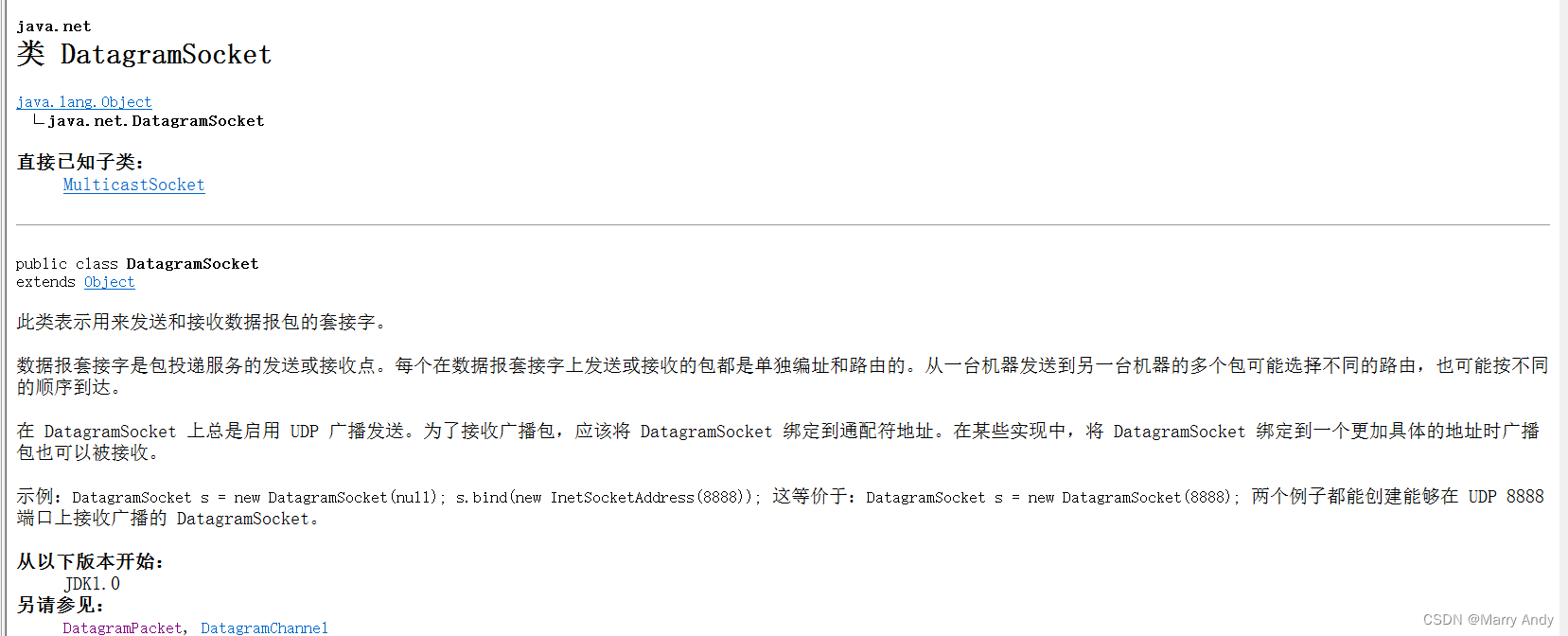 套接字就是发送方或接收方的地址
套接字就是发送方或接收方的地址
//服务端
package chat;
import java.io.IOException;
import java.io.InputStream;
import java.net.DatagramPacket;
import java.net.DatagramSocket;
import java.net.SocketException;
/**
* @Author marryandy
* @date 2022/5/5 20:53
* @Version 1.0
* @Description
*/
public class UdpReceiveDemo02 {
public static void main(String[] args) throws Exception {
//DatagramSocket相当于接收点的地址
DatagramSocket socket = new DatagramSocket(6666);
while(true){
//准备接收包裹
byte[] container = new byte[1024];
DatagramPacket packet = new DatagramPacket(container,0,container.length);
socket.receive(packet);//阻塞式接收包裹
//断开连接
byte[] data = packet.getData();
/*
String receiveData = new String(data, 0, data.length);
不能使用这个data.length,详见下面的解释
*/
String receiveData = new String(data, 0, packet.getLength());
System.out.println(receiveData);
if(receiveData.equals("bye")){
break;
}
}
//准备接收包裹
}
}

有个问题,就是客户端输入bye后,客户端程序停止运行,但是服务端,不停止运行。经过debug,发现,receiveData 的长度为1024惊呆了,这怎么可能相等,楼主现在只想到用写个for循环来字符串截取,想使用流技术来实现,无奈忘光了,等博主复习完再来!!
查到了,可以使用packet.getLength()方法,就是接收数据的长度


五、UDP实现客户端与服务器的简单聊天系统
分别在客户端和服务端使用两个线程来操作,使他们既可以发送信息也可以接收信息。
package chat;
import java.io.BufferedReader;
import java.io.IOException;
import java.io.InputStreamReader;
import java.net.DatagramPacket;
import java.net.DatagramSocket;
import java.net.InetSocketAddress;
import java.net.SocketException;
/**
* @Author marryandy
* @date 2022/5/6 14:16
* @Version 1.0
* @Description
*/
public class TalkSend implements Runnable {
DatagramSocket socket = null;
BufferedReader reader = null;
private int fromPort;
private String toIp;
private int toPort;
public TalkSend(int fromPort, String toIp, int toPort) {
this.fromPort = fromPort;
this.toIp = toIp;
this.toPort = toPort;
try {
socket = new DatagramSocket();
reader = new BufferedReader(new InputStreamReader(System.in));
} catch (SocketException e) {
e.printStackTrace();
}
}
@Override
public void run() {
while(true){
try {
String data = reader.readLine();
byte[] datas = data.getBytes();
DatagramPacket packet = new DatagramPacket(datas,0,datas.length,new InetSocketAddress(this.toIp,this.toPort));
socket.send(packet);
if (data.equals("bye")){
break;
}
} catch (IOException e) {
throw new RuntimeException(e);
}
}
socket.close();
}
}
package chat;
import java.io.IOException;
import java.net.DatagramPacket;
import java.net.DatagramSocket;
import java.net.SocketException;
/**
* @Author marryandy
* @date 2022/5/6 14:33
* @Version 1.0
* @Description
*/
public class TalkReceive implements Runnable{
DatagramSocket socket = null;
private int port;
private String msgFrom;
public TalkReceive(int port,String msgFrom) {
this.port = port;
this.msgFrom = msgFrom;
try {
socket = new DatagramSocket(port);
} catch (SocketException e) {
throw new RuntimeException(e);
}
}
@Override
public void run() {
while(true){
try {
//准备接收包裹
byte[] container = new byte[1024];
DatagramPacket packet = new DatagramPacket(container,0,container.length);
socket.receive(packet);//阻塞式接收包裹
//断开连接
byte[] data = packet.getData();
String receiveData = new String(data, 0, data.length);
System.out.println(msgFrom + ":" + receiveData);
if(receiveData.equals("bye")){
break;
}
} catch (IOException e) {
throw new RuntimeException(e);
}
}
//准备接收包裹
}
}
package chat;
/**
* @Author marryandy
* @date 2022/5/6 14:55
* @Version 1.0
* @Description
*/
public class TalkStudent {
public static void main(String[] args) {
//开启两个线程:他既有可能是接收端,也有可能是发送端
new Thread(new TalkSend(7777,"localhost",9999)).start();
new Thread(new TalkReceive(8888,"老师")).start();
}
}
package chat;
/**
* @Author marryandy
* @date 2022/5/6 14:59
* @Version 1.0
* @Description
*/
public class TalkTeacher {
public static void main(String[] args) {
//开启两个线程:他既有可能是接收端,也有可能是发送端,自己发送的端口无所谓
new Thread(new TalkSend(5555,"localhost",8888)).start();
new Thread(new TalkReceive(9999,"学生")).start();
}
}

六、URL
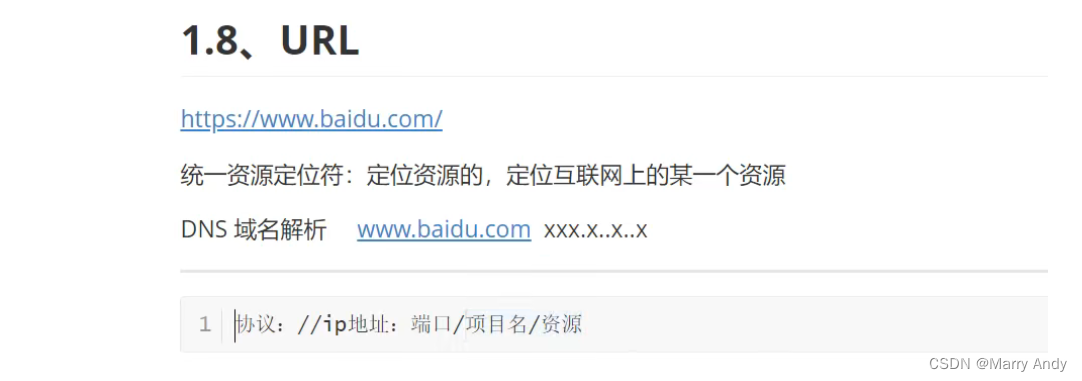
1、URL类
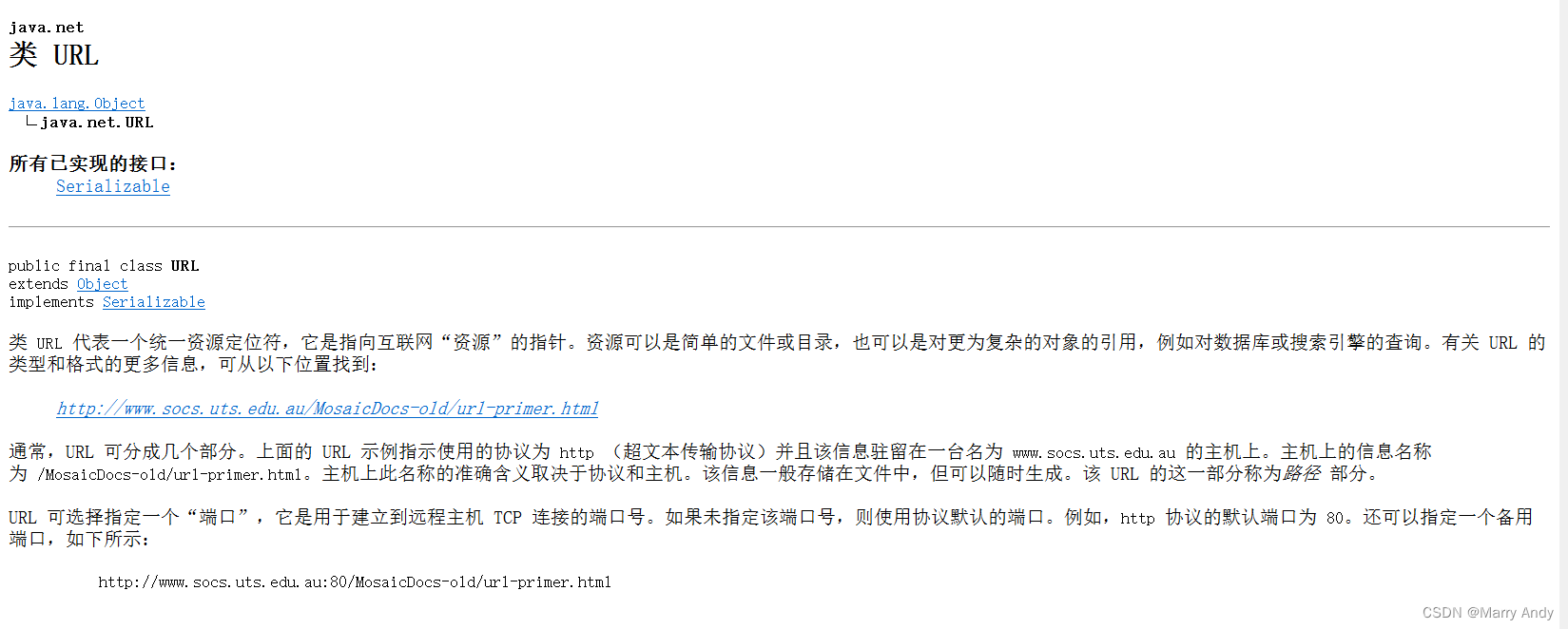
package URL;
import java.net.MalformedURLException;
import java.net.URL;
/**
* @Author marryandy
* @date 2022/5/6 15:37
* @Version 1.0
* @Description
*/
public class URLDemo01 {
//http://localhost:8080/MarryAndy/hello.txt
public static void main(String[] args) {
try {
URL url = new URL("http://locolhost:8080/helloword/index.jsp?username=MarryAndy&password=123");
System.out.println(url.getProtocol());//协议
System.out.println(url.getHost());//主机IP
System.out.println(url.getPort());//端口
System.out.println(url.getPath());//文件
System.out.println(url.getFile()); //文件全路径
System.out.println(url.getQuery());//参数
} catch (MalformedURLException e) {
throw new RuntimeException(e);
}
}
}

2、使用url下载网站上的资源
package URL;
import java.io.FileOutputStream;
import java.io.IOException;
import java.io.InputStream;
import java.net.HttpURLConnection;
import java.net.URL;
import java.net.URLConnection;
/**
* @Author marryandy
* @date 2022/5/6 15:50
* @Version 1.0
* @Description
*/
//使用url下载网站上的资源
public class URLDown {
public static void main(String[] args) throws Exception {
//1.下载地址
URL url = new URL("https://m704.music.126.net/20220506171202/095bc95b33fbf5270ceeb7d7be16554f/jdyyaac/obj/w5rDlsOJwrLDjj7CmsOj/14120501060/f1bb/04b6/3118/89db17878551efbf4f1c7f3268616d08.m4a?authSecret=00000180988d0c2c07300aa4638a1861");
//2.连接到这个资源 http,网络上一切都是流
HttpURLConnection urlconnection = (HttpURLConnection) url.openConnection();
InputStream inputStream = urlconnection.getInputStream();
FileOutputStream fos = new FileOutputStream("这个年纪.m4a");
byte[] buffer = new byte[1024];
int len;
while((len = inputStream.read(buffer)) != -1){
fos.write(buffer,0,len );//写出这个数据
}
fos.close();
inputStream.close();
urlconnection.disconnect();//断开连接
}
}
